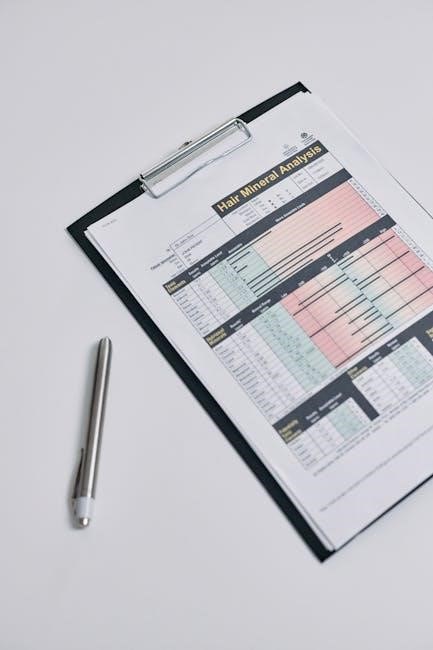The Mini-Mental State Examination (MMSE) is a widely used tool for assessing cognitive impairment and screening for dementia․ Developed by Folstein et al․ in 1975, it provides a structured approach to evaluating mental status through an 11-question format․ The MMSE PDF form is a standardized document that includes sections for orientation, registration, attention, recall, and language, making it a practical resource for clinicians and researchers․ Its simplicity and effectiveness have made it a cornerstone in cognitive assessments globally․
Overview of the MMSE
The Mini-Mental State Examination (MMSE) is a widely recognized, 11-question assessment tool designed to evaluate cognitive function․ It systematically tests five key areas: orientation, registration, attention and calculation, recall, and language․ The MMSE is scored out of 30, with higher scores indicating better cognitive performance․ A score of 24 or above typically suggests minimal cognitive impairment, while lower scores may indicate more significant issues․ The examination is brief, taking approximately 10 minutes to administer, making it a practical tool for clinicians․ Its structured format ensures consistency across assessments, providing a reliable measure of cognitive status․ The MMSE is often used in both clinical and research settings to monitor cognitive changes over time and assess the effectiveness of interventions․
Importance of the MMSE in Cognitive Assessment
The Mini-Mental State Examination (MMSE) is a widely recognized and essential tool in cognitive assessment, providing a standardized method to evaluate mental status․ Its importance lies in its ability to detect early signs of cognitive impairment, monitor disease progression, and assess the effectiveness of treatments․ The MMSE is particularly valuable for identifying dementia and other cognitive disorders in clinical and research settings․ It is also used to guide clinical decision-making and ensure timely interventions․ The examination’s brevity and simplicity make it accessible to non-specialists, while its structured format ensures reliability․ By focusing on key cognitive domains, the MMSE offers a comprehensive yet efficient way to understand an individual’s mental functioning, making it indispensable in healthcare and neuroscience․

Structure and Components of the MMSE
The MMSE is an 11-question assessment tool evaluating cognitive function through sections like orientation, registration, attention, calculation, recall, language, and motor skills, providing a comprehensive overview of mental status․
Orientation
The orientation section of the MMSE assesses the patient’s awareness of time and place․ It includes questions such as the year, season, date, day of the week, and month․ Patients are also asked about their location, including the country, state, city, hospital, and floor․ This section evaluates the ability to identify current temporal and spatial contexts․ Each correct answer earns one point, with a maximum score of 10 for this section․ The orientation questions are straightforward and serve as an initial gauge of cognitive function․ They are designed to detect disorientation, which may indicate cognitive impairment or confusion․ Accurate responses suggest intact awareness, while errors may signal deficits in memory or attention․
Registration
The registration section of the MMSE evaluates the patient’s ability to retain and repeat information․ The examiner states three unrelated objects, such as “apple, table, and car,” and asks the patient to repeat them immediately․ Each correctly recalled word earns one point, with a maximum score of 3․ This task assesses short-term memory and language comprehension․ The simplicity of this section makes it a reliable indicator of cognitive function․ If the patient struggles to repeat the words, it may suggest deficits in memory or attention․ The registration section is a critical component of the MMSE, providing insights into the patient’s ability to process and retain new information effectively․
Attention and Calculation
The attention and calculation section of the MMSE assesses the patient’s ability to focus and perform mental tasks․ A common exercise is the “serial sevens” test, where the patient is asked to subtract 7 from 100 repeatedly․ Alternatively, they may be asked to spell “WORLD” backward․ Each correct response earns one point, with a maximum score of 5․ This section evaluates working memory, concentration, and mental flexibility․ If the patient struggles with these tasks, it may indicate difficulties in maintaining attention or performing calculations, which could suggest cognitive impairment․ The simplicity of this section makes it an effective tool for clinicians to gauge mental acuity during assessments․
Recall
The recall section of the MMSE evaluates the patient’s ability to remember previously stated information․ During the examination, the examiner names three unrelated objects, such as “apple, table, flower,” and asks the patient to recall them after a short period․ Points are awarded for each correctly remembered item, with a maximum score of 3․ This task assesses short-term memory and the ability to retain and retrieve information․ If the patient struggles with recall, it may indicate memory impairment, a common symptom of cognitive disorders like dementia․ The simplicity of this section makes it an effective tool for clinicians to evaluate memory function in a standardized manner during cognitive assessments․
Language
The language section of the MMSE evaluates the patient’s ability to understand and use language effectively․ Tasks include naming simple objects (e․g․, pencil, watch), repeating a sentence (“No ifs, ands, or buts”), reading a command (“Close your eyes”), writing a sentence, and drawing a geometric shape․ Each task is scored based on accuracy, with a maximum of 8 points for this section․ This portion assesses verbal and written communication skills, providing insights into potential aphasia or other language-related cognitive impairments․ The clarity and correctness of responses help clinicians identify specific language deficits, making it a critical component of the MMSE for comprehensive cognitive assessment․
Administration and Scoring of the MMSE
The MMSE is administered via an 11-question format, requiring approximately 5-10 minutes to complete․ Standardized instructions ensure consistency across administrations, with scoring based on predefined criteria․
Scoring ranges from 0 to 30, with higher scores indicating better cognitive function․ Trained professionals typically administer the test, ensuring reliability and accuracy in assessing cognitive impairment․
Step-by-Step Administration Guidelines
The MMSE is administered in a structured, sequential manner to ensure consistency․ Begin with orientation questions, asking for the date, season, month, day, and year․ Allow 10 seconds for each response․ Next, assess registration by stating three unrelated words and asking the patient to repeat them․ For attention and calculation, request the patient to subtract 7 from 100 sequentially or perform a simple arithmetic task․ Memory recall is tested by asking the patient to repeat the three words mentioned earlier․ Language assessment involves naming objects, repeating phrases, and following commands․ Finally, evaluate the ability to write a sentence and draw a clock face․ Each section is scored individually, with points awarded for correct responses, ensuring systematic evaluation of cognitive function․
Scoring Criteria
The MMSE is scored on a scale of 0 to 30, with higher scores indicating better cognitive function․ Each question or task within the examination is assigned specific points, awarded for correct responses․ Orientation questions (e․g․, date, season, month) contribute up to 5 points, while registration (repeating three words) adds up to 3 points․ Attention and calculation tasks, such as serial subtraction, are worth 5 points․ Recall (remembering the three words) accounts for 3 points, and language tasks, including naming objects and repeating phrases, contribute up to 8 points․ Points are summed to determine the total score, with 24/25 often used as the cutoff for normal cognitive function․ Scores below 24 may indicate cognitive impairment, with lower scores reflecting greater severity․ Cultural and educational factors are considered when interpreting results․
Interpreting MMSE Scores
MMSE scores range from 0 to 30, with higher values indicating better cognitive function․ A score of 24 or above is generally considered normal, while scores below 24 suggest cognitive impairment․ The interpretation of scores is categorized as follows: 24-30 indicates no significant impairment, 18-23 suggests mild to moderate cognitive impairment, and scores below 18 indicate severe cognitive impairment․ These cutoffs are widely accepted but may vary slightly depending on the clinical context․ Clinicians consider age, education, and cultural background when interpreting results, as these factors can influence performance․ Lower scores may prompt further evaluation, but the MMSE alone is not diagnostic of dementia․ It is a screening tool to guide clinical decision-making and monitor changes over time․

Sections of the MMSE PDF Form
The MMSE PDF form includes structured sections: orientation questions, registration and attention tasks, memory and recall exercises, language assessments, and a sentence to copy․ Each section evaluates specific cognitive functions․
Orientation Questions
The orientation section of the MMSE assesses the individual’s awareness of time and place; Questions include asking for the year, season, date, day of the week, month, and location․ Participants are scored based on the accuracy of their responses, with one point awarded for each correct answer․ This section is designed to evaluate the person’s ability to understand their current surroundings and temporal context․ Correct answers demonstrate intact orientation, while errors may indicate cognitive impairment․ The orientation questions are foundational, providing insight into the individual’s basic awareness and serving as a starting point for further cognitive assessment․ This section is straightforward and requires clear, concise questioning to ensure accurate results․
Registration and Attention Tasks
The registration and attention tasks in the MMSE assess memory and cognitive processing․ Registration involves repeating named prompts, such as stating the examiner’s name or repeating phrases, to evaluate short-term memory and comprehension․ Attention tasks, like serial subtraction or spelling a word backward, test the ability to focus and perform mental calculations․ These exercises are designed to identify deficits in working memory and executive function․ Scoring is based on accuracy, with points awarded for correct responses․ This section helps differentiate between cognitive impairment and normal cognitive function, providing valuable insights into the individual’s mental state and ability to process information effectively․ It is a critical component of the MMSE, offering a clear measure of attentional and memory capabilities․
Memory and Recall Exercises
The memory and recall exercises in the MMSE evaluate the ability to remember and retrieve information․ Patients are typically asked to recall three unrelated words, such as “ball, car, tree,” and are scored based on their ability to repeat them correctly․ Additional questions, like “What is the date?” or “What is the year?” further assess recall of recent information․ These tasks are designed to identify impairments in short-term and long-term memory, which are critical indicators of cognitive function․ Accurate recall demonstrates intact memory processes, while difficulty suggests potential cognitive impairment․ This section is essential for diagnosing conditions like dementia and monitoring changes in cognitive abilities over time, providing valuable insights into memory function․

Practical Applications of the MMSE
The MMSE is widely used in clinical settings to diagnose cognitive impairment, monitor progress, and assess treatment effects․ It aids in care planning and research, providing valuable insights into cognitive function․
Use in Clinical Settings
The MMSE is a valuable tool in clinical settings for assessing cognitive function and detecting impairment․ Clinicians use it to diagnose dementia, monitor disease progression, and evaluate treatment effects․ The standardized PDF form ensures consistency across assessments․ It is particularly useful for screening patients with memory complaints and guiding care planning․ The MMSE’s brevity and simplicity make it accessible for routine use in hospitals, clinics, and research․ By evaluating key cognitive domains, it helps identify impairments early, enabling timely interventions․ Its widespread adoption underscores its reliability as a first-line assessment for cognitive dysfunction in various clinical populations․
Role in Diagnosing Cognitive Impairment
The Mini-Mental State Examination (MMSE) plays a crucial role in diagnosing cognitive impairment by assessing various cognitive functions․ It helps identify deficits in orientation, registration, attention, recall, and language, which are key indicators of cognitive decline․ The standardized PDF form ensures consistency in administration and scoring, making it a reliable tool for clinicians․ Early detection of cognitive impairment allows for timely interventions and personalized care plans․ The MMSE is particularly effective in distinguishing between different stages of cognitive decline, such as mild cognitive impairment or dementia․ Its widespread use in clinical and research settings underscores its value as a first-line diagnostic tool for cognitive assessments․
Monitoring Progress Over Time
The Mini-Mental State Examination (MMSE) is a valuable tool for monitoring cognitive changes in individuals over time․ By administering the test periodically, clinicians can track improvements or declines in cognitive function, providing insights into disease progression or treatment effectiveness․ The standardized PDF form ensures consistency across assessments, allowing for reliable comparison of scores over different time points․ Regular use of the MMSE helps identify subtle changes in cognitive abilities, such as memory, attention, and language skills, which may not be apparent through casual observation․ This longitudinal approach is particularly useful in managing conditions like dementia, enabling healthcare providers to adjust care plans and interventions as needed․ The MMSE’s simplicity and effectiveness make it an essential resource for long-term patient monitoring․

Limitations and Considerations
The MMSE has cultural and educational biases, potentially affecting accuracy․ It may not detect mild cognitive impairment and can be influenced by non-cognitive factors like motivation or motor skills․
Potential Biases and Limitations
The MMSE is not without biases and limitations․ Cultural and educational backgrounds can significantly influence scores, as certain tasks may favor individuals with higher education or specific cultural knowledge․ Language proficiency also plays a role, potentially affecting performance in non-native speakers․ Additionally, the MMSE may not accurately detect mild cognitive impairment or early stages of dementia, as it lacks sensitivity for subtle cognitive deficits․ It is also less effective in assessing individuals with severe aphasia or visual impairments․ Furthermore, the test’s ceiling effect can limit its ability to distinguish between high-functioning individuals․ These limitations highlight the need for complementary assessments to ensure accurate cognitive evaluations․
Cultural and Educational Influences
Cultural and educational backgrounds significantly influence MMSE scores, potentially leading to biased results․ The test’s design may favor individuals from specific cultural contexts or higher educational levels, as certain tasks assume familiarity with particular concepts or language․ For example, questions about date, time, or place may confuse those from different cultural calendars or environments․ Similarly, individuals with limited education may struggle with tasks requiring abstract thinking or complex language, even if their cognitive function is intact․ Language barriers further complicate accurate assessment, as non-native speakers may misunderstand instructions; These factors highlight the importance of considering cultural and educational contexts when interpreting MMSE results to ensure fair and reliable cognitive evaluations․
Comparisons with Other Cognitive Assessments
The MMSE is often compared to other cognitive assessments like the Montreal Cognitive Assessment (MoCA) and the Mini-Cog․ While the MMSE is widely used for its simplicity, the MoCA is considered more sensitive in detecting mild cognitive impairment․ The Mini-Cog, which includes a clock-drawing test and recall, is shorter but less comprehensive․ The MMSE’s focus on orientation, memory, and language aligns with its design for screening purposes․ However, it lacks the depth of executive function assessment found in tools like the Clock Drawing Test․ Despite these differences, the MMSE remains a standard due to its brevity and ease of administration, though clinicians often combine it with other assessments for a more detailed evaluation of cognitive function․
References and Resources
Key publications include Folstein et al․ (1975) and Tombaugh & McIntyre’s comprehensive review․ The MMSE PDF form is available via VA resources and academic journals like JAMA and J Psychiatr Res․
Key Publications on the MMSE
The MMSE was first introduced by Folstein, Folstein, and McHugh in their seminal 1975 paper titled “Mini-mental state: a practical method for grading the cognitive state of patients for the clinician”, published in the Journal of Psychiatric Research․ This foundational work established the MMSE as a standardized tool for cognitive assessment․ Another critical publication is Tombaugh and McIntyre’s comprehensive review of the MMSE, which provides detailed insights into its administration, scoring, and interpretation․ Additionally, Crum, Anthony, Bassett, and Folstein (1993) offered population-based norms for the MMSE, adjusting for age and educational level in JAMA․ These works, along with Rovner and Folstein’s 1987 article in Hospital Practice, remain essential references for clinicians and researchers using the MMSE PDF form in cognitive assessments․
Online Resources for MMSE Forms and Guides
Several online resources provide access to the MMSE PDF form and accompanying guides․ The official VA forms website offers a downloadable adapted MMSE form for clinical use․ Additionally, the U․S․ Department of Veterans Affairs provides detailed instructions and scoring guidelines․ Other reputable sources include academic publications and medical websites, such as JPR and JAMA, which host key publications on the MMSE․ These resources ensure healthcare professionals have easy access to standardized tools for cognitive assessments․